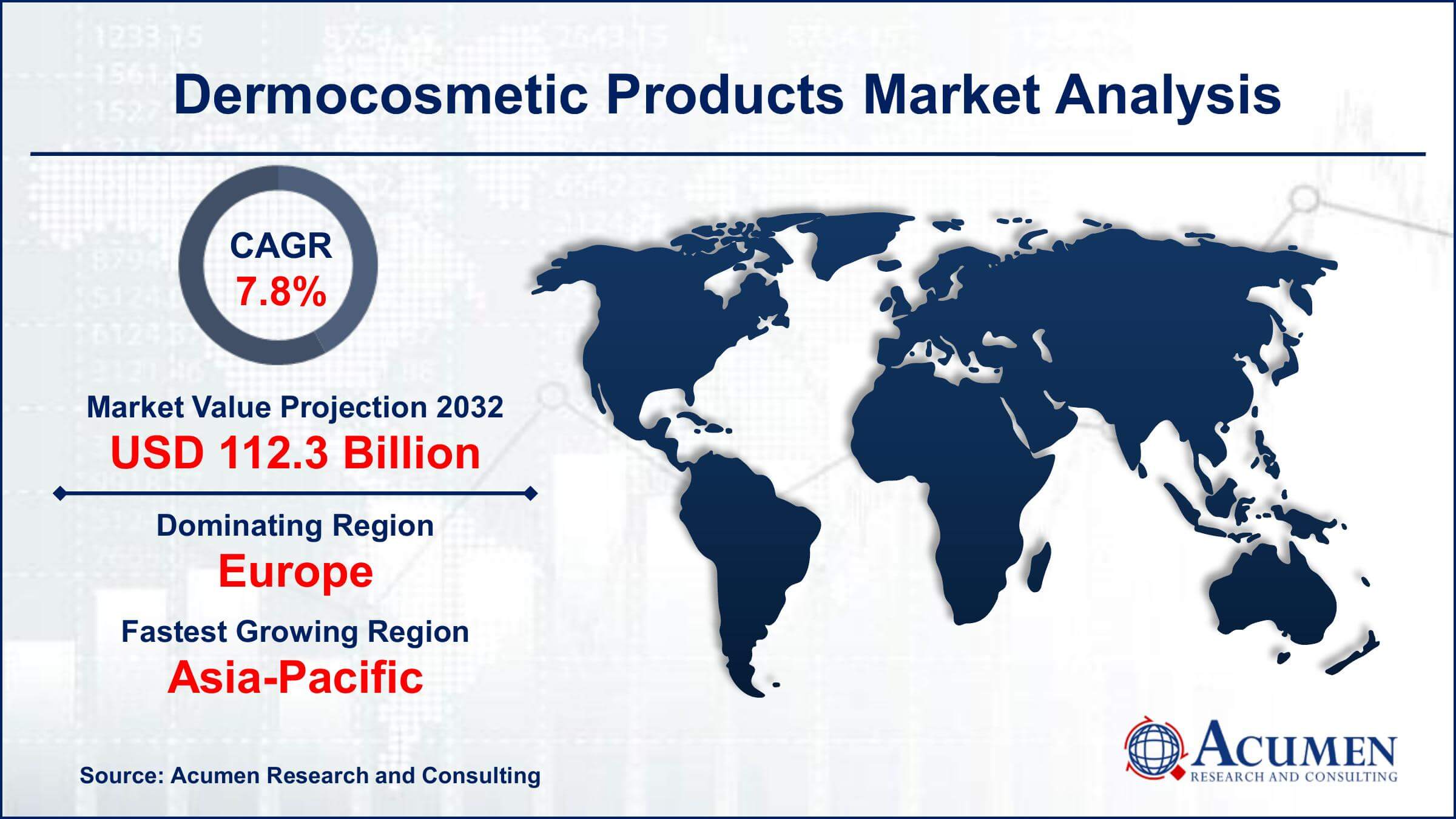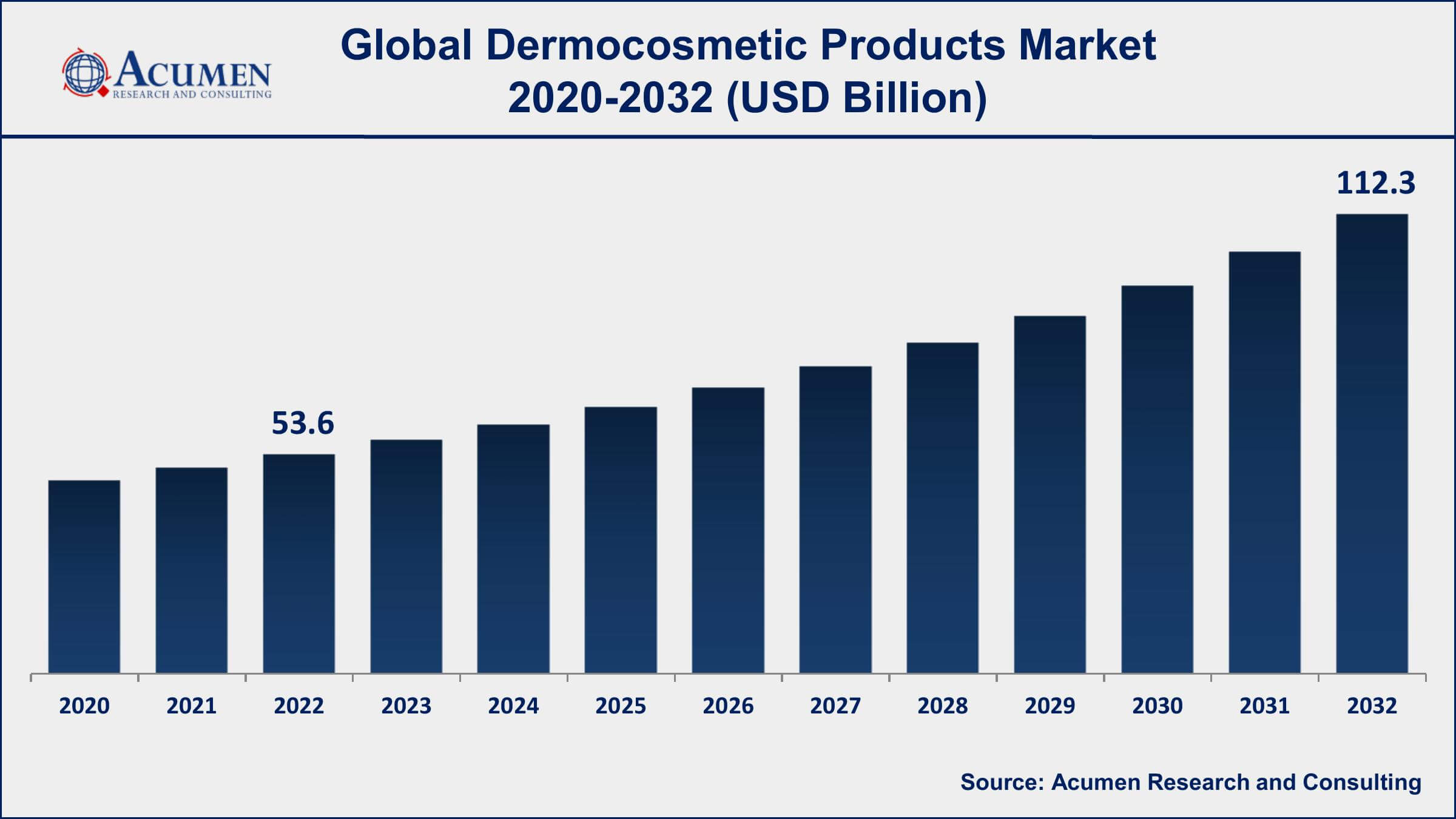Dermocosmetic Products Market | Acumen Research and Consulting
Dermocosmetic Products Market Size - Global Industry, Share, Analysis, Trends and Forecast 2023 - 2032
Published :
Report ID:
Pages :
Format :
The Global Dermocosmetic Products Market Size accounted for USD 53.6 Billion in 2022 and is projected to achieve a market size of USD 112.3 Billion by 2032 growing at a CAGR of 7.8% from 2023 to 2032.
Dermocosmetic Products Market Report Key Highlights
- Global dermocosmetic products market revenue is expected to increase by USD 112.3 Billion by 2032, with a 7.8% CAGR from 2023 to 2032
- Europe region led with more than 39% of dermocosmetic products market share in 2022
- Asia-Pacific dermocosmetic products market growth will record a CAGR of more than 9% from 2023 to 2032
- By type, the skincare products segment accounted for the largest share of the market in 2022
- By distribution channel, the online sales channel is expected to grow at a CAGR of 10.7% from 2023 to 2032
- Increasing awareness of the benefits of natural and organic skincare products, drives the dermocosmetic products market value

Dermocosmetic products are a combination of cosmetic and pharmaceutical products that are used for enhancing the health and beauty of the skin. These products are specially formulated to target specific skin concerns, such as acne, rosacea, hyperpigmentation, and aging. They are designed to be gentle on the skin and contain active ingredients that are scientifically proven to improve the health and appearance of the skin. Some of the common active ingredients in dermocosmetic products include retinoids, alpha hydroxy acids, vitamin C, and hyaluronic acid.
In recent years, the dermocosmetic market has seen significant growth due to an increasing focus on personal grooming, rising disposable income, and an increasing demand for high-quality skincare products. The increasing demand for anti-aging products, along with the growing prevalence of skin diseases, is driving the market growth. In addition, the increasing awareness of the harmful effects of synthetic chemicals on the skin has led to a surge in demand for natural and organic dermocosmetic products. The Asia Pacific region is expected to witness significant growth due to the rising population and increasing demand for personal grooming products in countries like China and India.

Global Dermocosmetic Products Market Trends
Market Drivers
- Increasing prevalence of skin diseases and disorders
- Growing demand for anti-aging products
- Rising disposable income and changing consumer lifestyle patterns
- Increasing awareness of the benefits of natural and organic products
- Growing popularity of multi-functional products
Market Restraints
- Stringent regulatory requirements for dermocosmetic products
- High cost associated with research and development
Market Opportunities
- Increasing demand for personalized skincare products
- Growing popularity of e-commerce platforms for the sale of dermocosmetic products
Dermocosmetic Products Market Report Coverage
| Market | Dermocosmetic Products Market |
| Dermocosmetic Products Market Size 2022 | USD 53.6 Billion |
| Dermocosmetic Products Market Forecast 2032 | USD 112.3 Billion |
| Dermocosmetic Products Market CAGR During 2023 - 2032 | 7.8% |
| Dermocosmetic Products Market Analysis Period | 2020 - 2032 |
| Dermocosmetic Products Market Base Year | 2022 |
| Dermocosmetic Products Market Forecast Data | 2023 - 2032 |
| Segments Covered | By Type, By Distribution Channel, And By Geography |
| Regional Scope | North America, Europe, Asia Pacific, Latin America, and Middle East & Africa |
| Key Companies Profiled | L'Oreal SA, Johnson & Johnson, Procter & Gamble, Unilever PLC, Estee Lauder Companies Inc., Shiseido Co. Ltd., Beiersdorf AG, Amway Corporation, Revlon Inc., Kao Corporation, Avon Products Inc., and Colgate-Palmolive Company. |
| Report Coverage |
Market Trends, Drivers, Restraints, Competitive Analysis, Player Profiling, Covid-19 Analysis, Regulation Analysis |
Dermocosmetic products are those products that are used to treat increasingly common skin problems such as acne, psoriasis, aczema, extreme sensitivity, and reactive skin. The increasing numbers of incidences regarding skin allergy and lifestyle-related skin complaints have augmented the demand for dermocosmetic products in the recent past. Increasing awareness regarding how the skin reacts to adverse conditions such as pollution and sunlight has led to the development of dermocosmetic products. These products are not considered beauty products, however, they definitely help enhance beauty.
The increasing youth population and rising awareness about the benefits of dermocosmetic products among this age group are anticipated to drive the demand throughout the forecast period. The rising disposable income of consumers is also expected to boost the growth of the global dermocosmetic products market over the forecast period. Another major reason for the rise in demand for dermocosmetic products is the growing consumer interest in wellness, health, and also benefit-driven products. The long-term benefits offered by dermocosmetic products are also projected to fuel the growth of this market over the forecast period. In addition to this, the minimal availability of substitutes also reduces the risk of substitutes in this market. This, in turn, is projected to be one of the significant opportunities for key players in this market. The major companies in this market have adopted the strategy of product development as the target consumers demand innovations in this market. The fluctuating consumer demand is expected to hamper the market growth over the forecast period.
Dermocosmetic Products Market Segmentation
The global dermocosmetic products market segmentation is based on type, distribution channel, and geography.
Dermocosmetic Products Market By Type
- Skin Care Products
- Acne Treatment
- Anti-Aging
- Skin Whitening
- Others
- Hair Care Products
- Anti-Dandruff
- Anti-Hair Fall
- Hair Repair
- Others
- Eye Care Products
- Artificial Tears
- Prescription Drops
- Others
In terms of types, the skin care products segment has seen significant growth in the recent years. The skincare products segment includes moisturizers, cleansers, sunscreens, anti-aging products, and other products that are used to enhance the health and appearance of the skin. The increasing demand for natural and organic skincare products, along with the growing awareness of the harmful effects of synthetic chemicals, is driving the growth of this segment. In addition, the rising demand for anti-aging products is also contributing to the growth of the skincare products segment. Moreover, the increasing prevalence of skin diseases and disorders, such as acne, rosacea, and hyperpigmentation, is driving the demand for dermatological skincare products. These products are designed to treat specific skin concerns and are often prescribed by dermatologists. The demand for dermatological skincare products is expected to increase in the coming years due to the growing prevalence of skin diseases.
Dermocosmetic Products Market By Distribution Channel
- Retail Stores
- Pharmacies
- Online Sales
According to the dermocosmetic products market forecast, the online sales segment is expected to witness significant growth in the coming years. With the increasing penetration of internet services and the proliferation of e-commerce platforms, online sales of dermocosmetic products have become an important channel for manufacturers to reach their target customers. The convenience of online shopping, along with the availability of a wide range of products at competitive prices, is driving the growth of this segment. Moreover, the increasing adoption of smartphones and tablets is also contributing to the growth of the online sales segment. In addition, the COVID-19 pandemic has further accelerated the growth of online sales of dermocosmetic products as consumers have become more reliant on e-commerce platforms to purchase essential items. The pandemic has also led to increasing demand for contactless shopping, which has further boosted the growth of the online sales segment.
Dermocosmetic Products Market Regional Outlook
North America
- U.S.
- Canada
Europe
- U.K.
- Germany
- France
- Spain
- Rest of Europe
Asia-Pacific
- India
- Japan
- China
- Australia
- South Korea
- Rest of Asia-Pacific
Latin America
- Brazil
- Mexico
- Rest of Latin America
The Middle East & Africa
- South Africa
- GCC Countries
- Rest of the Middle East & Africa (ME&A)

Dermocosmetic Products Market Regional Analysis
Europe is one of the dominant regions in the global dermocosmetic products market, with a significant market share. One of the primary factors is the high awareness of skincare and personal grooming among consumers in the region. Europeans are known for their high standards of personal grooming, and this has led to a growing demand for high-quality skincare products. Another factor contributing to Europe's dominance is the strong regulatory framework for skincare products. The European Union has stringent regulations for skincare products, which ensure that products are safe and effective. This has led to a high level of trust among consumers in the region, which has further boosted the demand for dermocosmetic products. Moreover, Europe has a well-established healthcare system, which has contributed to the growth of the dermocosmetic products industry.
Dermocosmetic Products Market Player
Some of the top dermocosmetic products market companies offered in the professional report include L'Oreal SA, Johnson & Johnson, Procter & Gamble, Unilever PLC, Estee Lauder Companies Inc., Shiseido Co. Ltd., Beiersdorf AG, Amway Corporation, Revlon Inc., Kao Corporation, Avon Products Inc., and Colgate-Palmolive Company.
Frequently Asked Questions
What was the market size of the global dermocosmetic products in 2022?
The market size of dermocosmetic products was USD 53.6 Billion in 2022.
What is the CAGR of the global dermocosmetic products market from 2023 to 2032?
The CAGR of dermocosmetic products is 7.8% during the analysis period of 2023 to 2032.
Which are the key players in the dermocosmetic products market?
The key players operating in the global market are including L'Oreal SA, Johnson & Johnson, Procter & Gamble, Unilever PLC, Estee Lauder Companies Inc., Shiseido Co. Ltd., Beiersdorf AG, Amway Corporation, Revlon Inc., Kao Corporation, Avon Products Inc., and Colgate-Palmolive Company.
Which region dominated the global dermocosmetic products market share?
Europe held the dominating position in dermocosmetic products industry during the analysis period of 2023 to 2032.
Which region registered fastest CAGR from 2023 to 2032?
Asia-Pacific region exhibited fastest growing CAGR for market of dermocosmetic products during the analysis period of 2023 to 2032.
What are the current trends and dynamics in the global dermocosmetic products industry?
The current trends and dynamics in the dermocosmetic products industry include increasing prevalence of skin diseases and disorders, growing demand for anti-aging products, and rising disposable income and changing consumer lifestyle patterns.
Which type held the maximum share in 2022?
The skin care products type held the maximum share of the dermocosmetic products industry.



